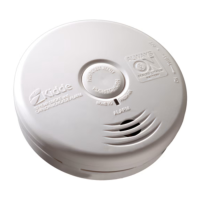NFPA 72 states: “Smoke alarms in rooms with ceiling slopes greater than
1 ft in 8 ft (.3m in 2.4 m) horizontally shall be located on the high side of
the room.” NFPA 72 states: “A row of detectors shall be spaced and locat-
ed within 3 ft (0.9m) of the peak of the ceiling measured horizontally.”
2. RECOMMENDED LOCATIONS FOR ALARMS
• Locate the smoke alarms in all sleeping areas. Try to monitor the exit path
as the bedrooms are usually farthest from the exit. If more than one sleeping
area exists, locate additional alarms in each sleeping area.
• Locate additional alarms to monitor any stairway as stairways act like
chimneys for smoke and heat.
• Locate at least one alarm on every floor level.
• Locate an alarm in every bedroom.
• Locate an alarm in every room where electrical appliances are operated
(i.e. portable heaters or humidifiers).
• Locate an alarm in every room where someone sleeps with the door
closed. The closed door may prevent an alarm not located in that room
from waking the sleeper.
• Smoke, heat, and combustion products rise to the ceiling and spread
horizontally. Mounting the smoke alarm on the ceiling in the center of
the room places it closest to all points in the room. Ceiling mounting is
preferred in ordinary residential construction.
• For mobile home installation, select locations carefully to avoid thermal
ANYWHERE ALONG
THIS BOLD SURFACE
30.5 cm
Locations permitted for smoke
alarms and smoke detectors
on tray-shaped ceilings.
ANYWHERE ALONG
THIS BOLD SURFACE
30.5 cm
Locations permitted for smoke
alarms and smoke detectors
on tray-shaped ceilings.
FIGURE 1
ANYWHERE ALONG
THIS BOLD SURFACE
30.5 cm
Locations permitted for smoke
alarms and smoke detectors
on tray-shaped ceilings.
FIGURE 2 FIGURE 3
1. LIMITATIONS OF CARBON MONOXIDE ALARMS
WARNING: PLEASE READ CAREFULLY AND THOROUGHLY
• IMPORTANT: This carbon monoxide alarm is designed to detect carbon
monoxide gas from ANY source of combustion. It is NOT designed to detect
any other gas.
• CAUTION: This alarm will only indicate the presence of carbon monoxide gas
at the sensor. Carbon monoxide gas may be present in other areas. Never
restart the source of a CO problem until it has been fixed. NEVER IGNORE
THE ALARM!
WARNING: This product is intended for use in ordinary indoor
locations of family living units. It is not designed to measure compli-
ance with Occupational Safety and Health Administration (OSHA),
commercial or industrial standards. It is not suitable for installation in
hazardous locations as defined in the National Electric Code. It is not
designed for use in a recreational vehicle (RV) or boat.
• The installation of this device should not be used as a substitute for proper
installation, use and maintenance of fuel burning appliances, including
appropriate ventilation and exhaust systems.
• This alarm does not prevent CO from occurring, nor can it solve any existing
CO problem.
WARNING: This device is designed to protect individuals from
acute effects of carbon monoxide exposure. It may not fully safeguard
individuals with specific medical conditions. If in doubt, consult a med-
ical practitioner. Individuals with medical problems may consider using
warning devices which provide audible and visual signals for carbon
monoxide concentrations under 30 PPM.
• This alarm has not been investigated for carbon monoxide detection below
70 PPM.
• This carbon monoxide alarm requires a continuous supply of electrical power
– it will not work without power.

